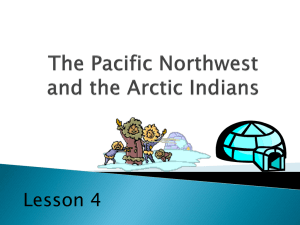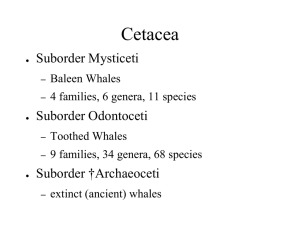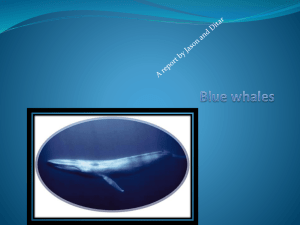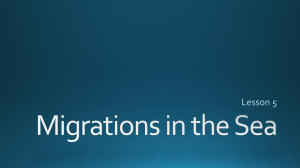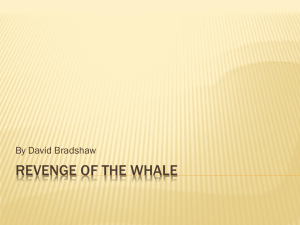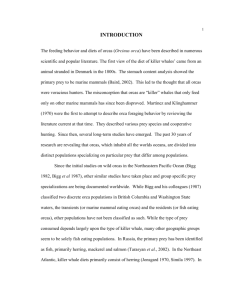Vessel Traffic Disru..
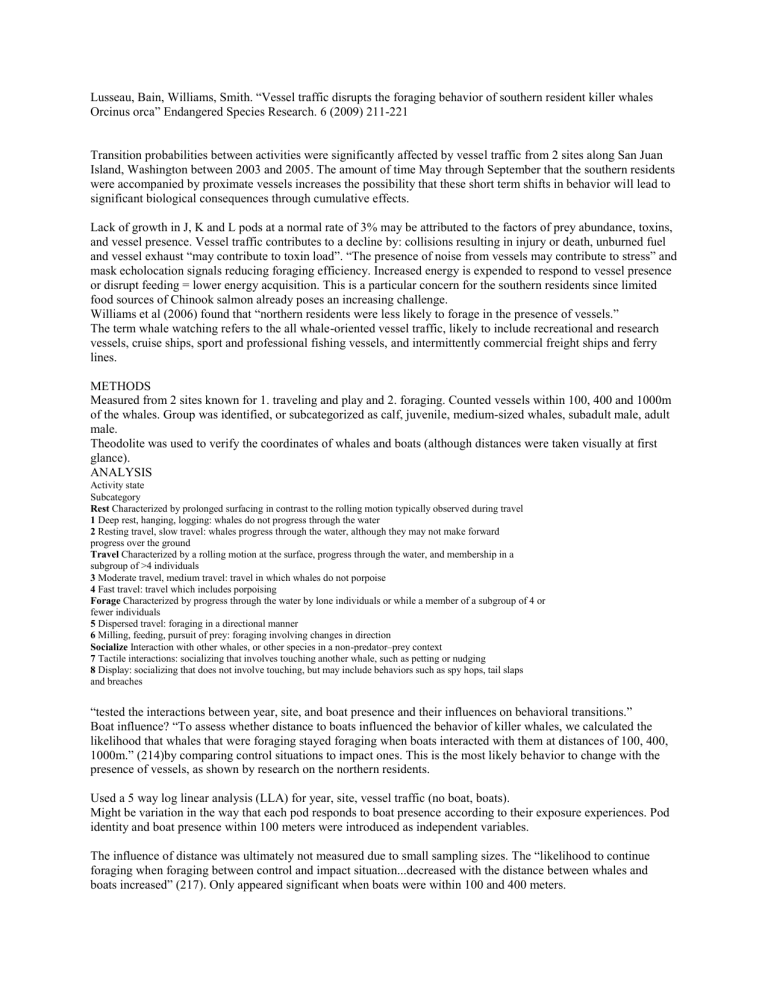
Lusseau, Bain, Williams, Smith. “Vessel traffic disrupts the foraging behavior of southern resident killer whales
Orcinus orca” Endangered Species Research. 6 (2009) 211-221
Transition probabilities between activities were significantly affected by vessel traffic from 2 sites along San Juan
Island, Washington between 2003 and 2005. The amount of time May through September that the southern residents were accompanied by proximate vessels increases the possibility that these short term shifts in behavior will lead to significant biological consequences through cumulative effects.
Lack of growth in J, K and L pods at a normal rate of 3% may be attributed to the factors of prey abundance, toxins, and vessel presence. Vessel traffic contributes to a decline by: collisions resulting in injury or death, unburned fuel and vessel exhaust “may contribute to toxin load”. “The presence of noise from vessels may contribute to stress” and mask echolocation signals reducing foraging efficiency. Increased energy is expended to respond to vessel presence or disrupt feeding = lower energy acquisition. This is a particular concern for the southern residents since limited food sources of Chinook salmon already poses an increasing challenge.
Williams et al (2006) found that “northern residents were less likely to forage in the presence of vessels.”
The term whale watching refers to the all whale-oriented vessel traffic, likely to include recreational and research vessels, cruise ships, sport and professional fishing vessels, and intermittently commercial freight ships and ferry lines.
METHODS
Measured from 2 sites known for 1. traveling and play and 2. foraging. Counted vessels within 100, 400 and 1000m of the whales. Group was identified, or subcategorized as calf, juvenile, medium-sized whales, subadult male, adult male.
Theodolite was used to verify the coordinates of whales and boats (although distances were taken visually at first glance).
ANALYSIS
Activity state
Subcategory
Rest Characterized by prolonged surfacing in contrast to the rolling motion typically observed during travel
1 Deep rest, hanging, logging: whales do not progress through the water
2 Resting travel, slow travel: whales progress through the water, although they may not make forward progress over the ground
Travel Characterized by a rolling motion at the surface, progress through the water, and membership in a subgroup of >4 individuals
3 Moderate travel, medium travel: travel in which whales do not porpoise
4 Fast travel: travel which includes porpoising
Forage Characterized by progress through the water by lone individuals or while a member of a subgroup of 4 or fewer individuals
5 Dispersed travel: foraging in a directional manner
6 Milling, feeding, pursuit of prey: foraging involving changes in direction
Socialize Interaction with other whales, or other species in a non-predator–prey context
7 Tactile interactions: socializing that involves touching another whale, such as petting or nudging
8 Display: socializing that does not involve touching, but may include behaviors such as spy hops, tail slaps and breaches
“tested the interactions between year, site, and boat presence and their influences on behavioral transitions.”
Boat influence? “To assess whether distance to boats influenced the behavior of killer whales, we calculated the likelihood that whales that were foraging stayed foraging when boats interacted with them at distances of 100, 400,
1000m.” (214)by comparing control situations to impact ones. This is the most likely behavior to change with the presence of vessels, as shown by research on the northern residents.
Used a 5 way log linear analysis (LLA) for year, site, vessel traffic (no boat, boats).
Might be variation in the way that each pod responds to boat presence according to their exposure experiences. Pod identity and boat presence within 100 meters were introduced as independent variables.
The influence of distance was ultimately not measured due to small sampling sizes. The “likelihood to continue foraging when foraging between control and impact situation...decreased with the distance between whales and boats increased” (217). Only appeared significant when boats were within 100 and 400 meters.
“Whales tended to spend significantly more time traveling and less time foraging when boats were present within
100 m than when they were absent within 100 m.” (218)
“The present study shows that whales are displaced short distances by the presence of vessels. Thus, whales may be displaced from optimal foraging routs....noise would mask echolocation signals and reduce foraging efficiency”
(219).
Further study is suggested for how noise and proximity interact to reduce foraging effort. Future could also compare types of whale watching to analyze impacts of leap frogging vs paralleling. Individual responses to vessels impacted by age, sex, pod, or individual?
“Boats within 100 m clearly have a significant effect on whale behavior. Boats between 100 and 400 m also have a significant effect, although we cannot say whether boats throughout this range cause effects, or the significance is due to the effects of vessels just over 100 m away.” Similar but smaller differences were observed when the closest vessels were 400 to 1000 m away but a larger sample is required to draw significant conclusions.
(219)
Research suggests that whales are able to detect prey directly in their path, but vessel noise inhibits their ability to detect prey off to the side of their path (by a masking vessel disturbance).

